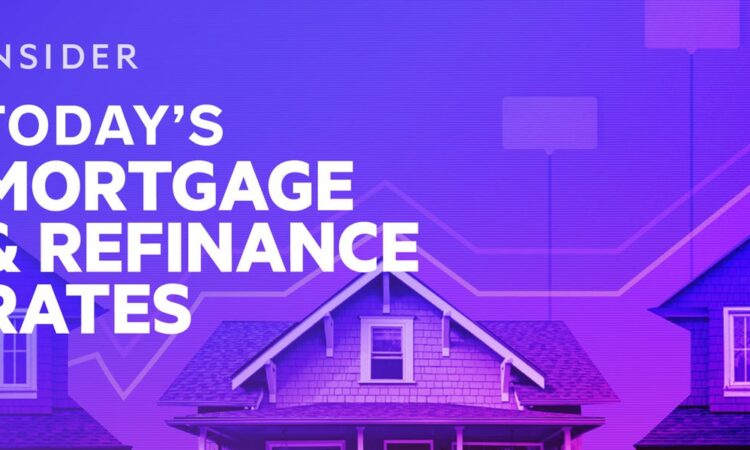
Our experts answer readers’ home-buying questions and write unbiased product reviews (here’s how we assess mortgages). In some cases, we receive a commission from our partners; however, our opinions are our own.
Mortgage rates have trended downward over the last few days, and they might continue to decrease in the coming weeks.
The average 30-year mortgage rate is 7.76%, according to Freddie Mac — while this is still relatively high, it’s three basis points lower than the week before. This is the first time rates have gone down in two months.
The October jobs report showed that the US added fewer jobs than expected last month. The Federal Reserve also opted to pause the federal funds rate at its meeting last week. These are two signs that the economy is starting to cool, which is often a good sign for mortgage rates.
However, Fed Chair Jerome Powell has said the central bank would consider raising the federal funds rate again if inflation still isn’t under control. We’ll need to see long-term, consistent signs that the US economy is cooling off for mortgage rates to drop significantly.
Current Mortgage Rates
| Mortgage type | Average rate today |
|
|
|
|
|
|
|
|
|
|
|
|
|
|
|
|
|
|
|
|
|
Current Refinance Rates
| Mortgage type | Average rate today |
|
|
|
|
|
|
|
|
|
|
|
|
|
|
|
|
|
|
|
|
|
Mortgage Calculator
Use our free mortgage calculator to see how today’s mortgage rates would impact your monthly payments. By plugging in different rates and term lengths, you’ll also understand how much you’ll pay over the entire length of your mortgage.
Mortgage Calculator
$1,161
Your estimated monthly payment
- Paying a 25% higher down payment would save you $8,916.08 on interest charges
- Lowering the interest rate by 1% would save you $51,562.03
- Paying an additional $500 each month would reduce the loan length by 146 months
Click “More details” for tips on how to save money on your mortgage in the long run.
30-year Fixed Mortgage Rates
Last week, the average 30-year fixed mortgage rate was 7.76%, according to Freddie Mac. This is a three-point decrease from the previous week.
The 30-year fixed-rate mortgage is the most common type of home loan. With this type of mortgage, you’ll pay back what you borrowed over 30 years, and your interest rate won’t change for the life of the loan.
The lengthy 30-year term allows you to spread out your payments over a long period of time, meaning you can keep your monthly payments lower and more manageable. The trade-off is that you’ll have a higher rate than you would with shorter terms or adjustable rates.
15-year Fixed Mortgage Rates
Average 15-year mortgage rates were 7.03% last week, unchanged from the previous week, according to Freddie Mac data.
If you want the predictability that comes with a fixed rate but are looking to spend less on interest over the life of your loan, a 15-year fixed-rate mortgage might be a good fit for you. Because these terms are shorter and have lower rates than 30-year fixed-rate mortgages, you could potentially save tens of thousands of dollars in interest. However, you’ll have a higher monthly payment than you would with a longer term.
When Will Mortgage Rates Go Down?
Mortgage rates started ticking up from historic lows in the second half of 2021 and increased over three percentage points in 2022. Rates have increased dramatically this year.
As inflation comes down, mortgage rates will recede somewhat as well. If we experience a recession, rates may drop a little faster. But average 30-year fixed rates will likely remain somewhere in the 7% to 8% range in the near term.
For homeowners looking to leverage their home’s value to cover a big purchase — such as a home renovation — a home equity line of credit (HELOC) may be a good option while we wait for mortgage rates to ease. Check out some of our best HELOC lenders to start your search for the right loan for you.
A HELOC is a line of credit that lets you borrow against the equity in your home. It works similarly to a credit card in that you borrow what you need rather than getting the full amount you’re borrowing in a lump sum. It also lets you tap into the money you have in your home without replacing your entire mortgage, like you’d do with a cash-out refinance.
Current HELOC rates are relatively low compared to other loan options, including credit cards and personal loans.
How Do Fed Rate Hikes Affect Mortgages?
The Federal Reserve has been increasing the federal funds rate this year to try to slow economic growth and get inflation under control. So far, inflation has slowed, but it’s still above the Fed’s 2% target rate.
Mortgage rates aren’t directly impacted by changes to the federal funds rate, but they often trend up or down ahead of Fed policy moves. This is because mortgage rates change based on investor demand for mortgage-backed securities, and this demand is often impacted by how investors expect Fed hikes to affect the broader economy.
As inflation starts to come down, mortgage rates should, too. But the Fed has indicated that it’s watching for sustained signs of slowing inflation.






